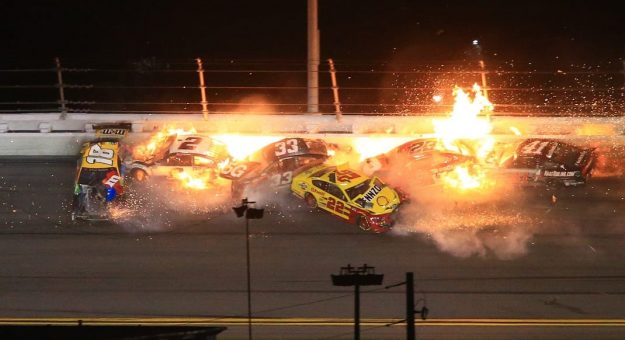
HARRISBURG, N.C. — As someone who has written about auto racing for nearly four decades, I have a genuine concern for the long-term future of the Daytona 500.
The annual 500-mile battle at Bill France’s 2.5-mile Palace of Speed has been a crown jewel event for NASCAR racing since Lee Petty and Johnny Beauchamp crossed the finish line side by side on Feb. 22, 1959.
That dramatic finish was a preview of things to come.
During the 1960s and ’70s, race fans from across the country migrated south to the Sunshine State each February to spend time on the beach and cheer for the brave men who navigated the high banks of Daytona Int’l Speedway in stock-appearing automobiles.
The action often kept fans on the edge of their seats, such as the dramatic finish to the 1976 Daytona 500, when rivals Richard Petty and David Pearson tangled and crashed coming off of turn four on the final lap.
Three years later, live television coverage of the Daytona 500 forever changed the NASCAR landscape and the sport’s marquee race was soon being mentioned alongside major events in mainstream, stick-and-ball sports.

Thanks to broadcaster Ken Squier, the 500 even became known as The Great American Race.
Fast-forward to more recent times and the Daytona 500 has become better known for its dramatic, multi-car crashes that regularly eliminate a majority of the competitors and play a significant role in determining who takes the checkered flag. To most race fans, today’s Daytona 500 is a demolition derby instead of a race.
Combine that pathetic style of racing with the expected afternoon showers that delayed this year’s race for nearly six hours, and it’s no wonder the television ratings for the 63rd running of the Daytona 500 hit a new low.
People don’t like the current style of racing on the Daytona tri-oval and they are turning their attention elsewhere, and that’s a bad sign for the future of NASCAR’s most significant race.
If something doesn’t change, the Daytona 500 could easily fade into the history books.
Don’t believe me; look what’s happened to the Brickyard 400. When the NASCAR Cup Series made its first visit to the legendary Indianapolis Motor Speedway in August 1994, it was one of the most significant events in the history of American motorsports.
The annual race attracted enormous crowds and drew impressive TV numbers as it helped fuel NASCAR’s amazing growth during the late 1990s.
The Brickyard 400 became one of NASCAR’s crown jewel races alongside the Daytona 500, Coca-Cola 600 and Southern 500.
Then, stock car racing’s annual visit to Indianapolis began to fall on hard times. Tire issues marred the 2008 race, crowds began to dwindle and it was finally acknowledged that the unique rectangular shape of the Indy track was simply not conducive to good stock car racing.
This year, NASCAR’s visit to Indianapolis Motor Speedway will be run on the facility’s road course, essentially ending the storied tradition of the Brickyard 400 and relegating a former marquee event to the history books.
The winner and his team will still kiss the bricks at the start-finish line after the checkered flag, but it will be the end of one era and the beginning of another.
If changes are not made to address the current issues in NASCAR’s hometown, what will the Daytona 500 look like five years, 10 years down the road?
Will Daytona and NASCAR officials be able maintain the race’s prestige, or will it experience a similar fate to the Brickyard 400? What impact will NASCAR’s Next Gen car have on the sport’s signature race when it debuts next year? Will it fix the racing?
At this point, there are certainly more questions than answers concerning the future of the Daytona 500.
